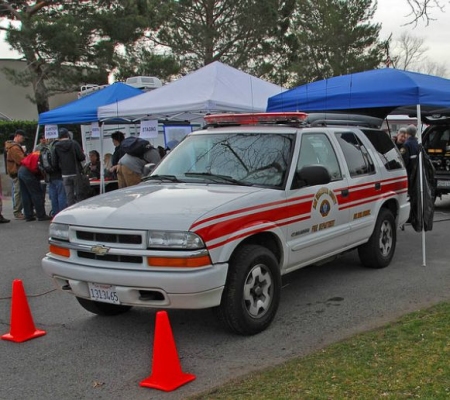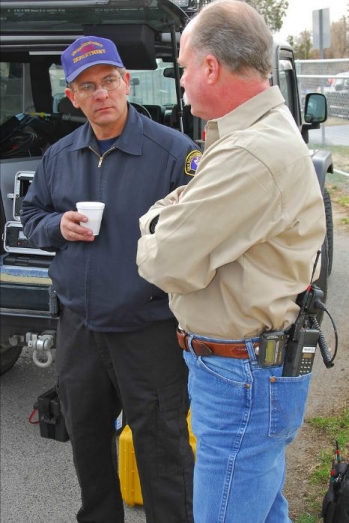Leisa Hurst Search #2
I had the opportunity to work with the San Bernardino County Emergency Communications Service (SBCECS) to provide radio communications for a ground search activity.
We were conducting a second ground search for evidence or clues regarding Leisa Ann Hurst, a missing 30-yr old mother of two from Barstow, CA. I was impressed by their efficiency and professionalism, and I believe some of their procedures are worthy of imitation.
The victim, Leisa Hurst, a 30 year old mother of two, was last seen on January 22, 2009, dropping her children off at school in the morning. Foul play was suspected. The male suspect, allegedly involved in a romantic relationship with her, is now in custody.
A first family-organized search for clues had been conducted on February 7th, which, although improvised, still covered a large area and had over 175 volunteers participating. It was a loose family-organized search, with the Barstow PD assisting in an advisory role. A friend of the family had some FRS-capable radios which were distributed to the teams. Many people brought all-terrain vehicles (ATVs) out to help with the desert search.
The second search was scheduled for two weeks later, which provided time to request other resources, like the SBCECS. A non-profit search organization, Trinity Search & Recovery, had been contacted by the family and would organized the search. Trinity has had experience handling many search missions and brought skills of resources, organization, management, and reporting to the aid of the families.
There was also a food truck from a local church organization which served a chicken soup lunch, and egg burritos for breakfast. Volunteers from off-road associations helped, and a group of a dozen ‘Hummers’ were there. Another private company brought a small unmanned aerial vehicle (UAV) drone, which was remotely piloted above one of the search area, taking high resolution pictures of the ground, and logging a GPS track. Quite interesting.
Being close to the families, I inquired how to ask for mutual aid communications support, and was advised to contact a neighboring agency with information in the Yellow Book. I made contact and sent some information, and was told they would look into helping and request approval.
I was contacted soon after by Tracy Lenocker, Captain of the Central Mountain ECS team, who said his group would be helping out. They were classifying their involvement as a training exercise for his group.
I was relieved when I heard they would help. They had resources including portable repeaters, frequency access, trained personnel, self-sufficient operations, and even satellite phone access if requested. I assured the families that they would have a solid communications network, and it worked out very well.
The ECS team arrived with Chevy Blazer-type vehicles with hatch-backs that opened to reveal rear-of-vehicle communications consoles. They had three vehicles which backed-in to park (for quick getaways), which created a good communications setup under an Easy-Up with portable tables and chairs. They also had a portable mast/tripod with antenna for back-up in case the repeater setup failed for some reason.
As far as the communications plan, it was decided to ask for permission from a local repeater owner to use the Victor Valley repeater for amateur use, which had good coverage where the search area would be. There was also good cell phone coverage, and this was designated as a backup method. Because many volunteers had GMRS radios, a cross-band system was set up with a mobile unit and antenna atop a local mountain repeater site tower, repeating the general-use frequency over to the output of a county OES repeater frequency which ECS had pre-programmed into their radios. Fortunately, the team leaders arrived the night before, which was fortunate since the OES repeater that they were to use failed. One member drove up the moon lit unpaved road to the mountaintop and installed an emergency repeater.
Interestingly, later in the afternoon, we heard other distant search operations in progress in the Mt. Baldy and Chino area, since the county OES repeaters all shared the same output frequency, but different input tones based on geographic location.
Procedurally, the group was highly trained and organized. They had individual roles assigned to handle radio operations, radio traffic logging, equipment check-out, and roll-call tracking also.
After the search teams were dispatched, the operators conducted roll-calls of the teams on the hour and half-hour, with odd-numbered teams on the hour and even-numbered teams on the half-hour. They tracked check-ins on a dry-erase board, and it was easy to visually see which teams maintained good communication. Once an hour the dispatcher identified as the San Bernardino County Fire Department and announced that the channel was closed to routine communications due to an emergency operation. After some initial complaints the channel went quiet and we continued.
Having two nets [three], an amateur and a GMRS, was helpful to maintain contact with over 20 search teams in different modes. Four-wheel drive vehicles, ATVs, foot searchers, and even an unmanned aerial drone were among the assets used for the search.
The ECS, as well as the search & recovery management, used pre-filled ICS forms for the activity, which were later submitted to Barstow PD to go in the case file.
Another interesting element was sending cell phone pictures. Search teams were instructed to take a picture of any potential clues in the field with their cell phones and text them back to the assigned command post cell phone. I ended up receiving, tracking, and logging the pictures and showing them to the supervisor. Sometimes, a rover unit would be dispatched for further investigation of the location. Items included old pieces of clothing, disturbed dirt areas or mounds of dirt, although none proved significant to the investigation.
As with any activity, there often are lessons learned. One need ECS recognized was to have a second call logger assigned for the second channel. Often different traffic calls came through on the two frequencies, and one call logger had a hard time logging both sets of information at once. Next time they will assign individual scribes to each channel’s traffic.
I noticed the roll-call table drawn on the dry-erase board was very helpful to organize the hourly check-ins and visually identify which teams we had contact with. These two aspects of documentation assignments and team/resource tracking are worthy of imitation and should be considered when activated and supporting numerous units in the field.
Although no significant clues regarding the victim’s disappearance were discovered, the operation was a great success and an encouragement to the families. Statistically, 276 volunteers participated, in over 20 search teams, logging around 2,500 volunteer man-hours and 2,000 specific search man-hours. It was amazing to see how many groups came to help out in the family’s time of need. A great show of support and volunteerism.
At the conclusion of the day a team member took the search grid map down and presented it to the grieving family. The searchers were saddened that they had not located Leisa.




Minor edits have been made for accuracy.